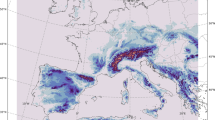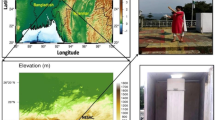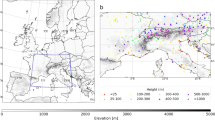Abstract
An attempt is made to correlate the mixing heights, derived from ceilometer and Sodar measurements, to those simulated by different atmospheric boundary-layer parameterization schemes. The comparison is performed at two sites (one suburban and one rural) close to Munich, Germany for two spring and two winter days. It is found that, under convective conditions, the mixing height determined, by both Sodar and ceilometer, corresponds to the middle or the top of the entrainment zone, respectively, as calculated from the eddy-viscosity profiles. Under stable conditions, the measured mixing height is related to the height where eddy viscosities attain their minimum values (Sodar) or to the height of residual mechanical turbulence (ceilometer). During a foehn case with weak turbulence, the measured mixing height from both Sodar and ceilometer is better inferred by considering the eddy-viscosity profiles during daytime and the height of the low-level jet during nighttime.
Similar content being viewed by others
References
Akylas E, Tombrou M (2005) Reconsidering and generalized interpolation between Kansas-type formulae and free convection forms. Boundary-Layer Meteorol 115: 381–398. doi:10.1007/s10546-004-1426-3
Akylas E, Tsakos Y, Tombrou M, Lalas DP (2003) Considerations on minimum friction velocity. Q J Roy Meteorol Soc 129: 1929–1943. doi:10.1256/qj.01.73
Beyrich F (1997) Mixing height estimation from sodar data—a critical discussion. Atmos Environ 31: 3941–3953. doi:10.1016/S1352-2310(97)00231-8
CORINE CLC (2000) European Commission CORINE land cover technical guide. ISBN 92-9167-697-7
Dandou A, Tombrou M, Akylas E, Soulakellis N, Bossioli E (2005) Development and evaluation of an urban parameterization scheme in the Penn State/NCAR Mesoscale Model (MM5). J Geophys Res 110: D10102. doi:10.1029/2004JD005192
de Haij M, Wauben W, Klein H (2006) Determination of mixing layer height from ceilometer backscatter profiles. In: Remote sensing of clouds and the atmosphere XI, proceedings of the SPIE, vol 6362. doi:10.1117/12.691050
Dudhia J (1989) Numerical study of convection observed during the winter monsoon experiment using a mesoscale two-dimensional model. J Atmos Sci 46: 3077–3107. doi:10.1175/1520-0469(1989)046<3077:NSOCOD>2.0.CO;2
Dudhia J (1996) A multi-layer soil temperature model for MM5. Preprints, the 6th PSU/NCAR mesoscale model users, workshop, Boulder, CO, July. National Centre for Atmospheric Research, pp 49–50
Emeis S, Schäfer K (2006) Remote sensing methods to investigate boundary layer structures relevant to air pollution in cities. Boundary-Layer Meteorol 121(2): 377–385. doi:10.1007/s10546-006-9068-2
Emeis S, Türk M (2004) Frequency distributions of the mixing height over an urban area from SODAR data. Meteorol Z 13: 361–367. doi:10.1127/0941-2948/2004/0013-0361
Emeis S, Münkel C, Vogt S, Müller WJ, Schäfer K (2004) Atmospheric boundary-layer structure from simultaneous SODAR, RASS, and ceilometer measurements. Atmos Environ 38: 273–286. doi:10.1016/j.atmosenv.2003.09.054
Eresmaa N, Karppinen A, Joffre SM, Räsänen J, Talvitie H (2006) Mixing height determination by ceilometer. Atmos Chem Phys 6: 1485–1493
Garratt JR (1992) The atmospheric boundary layer. Cambridge University Press, UK, p 316
Grachev AA, Fairall CW, Bradley EF (2000) Convective profile constants revised. Boundary-Layer Meteorol 94: 495–515. doi:10.1023/A:1002452529672
Grell GA (1993) Prognostic evaluation of assumptions used by cumulus parameterizations. Mon Weather Rev 121: 764–787. doi:10.1175/1520-0493(1993)121<0764:PEOAUB>2.0.CO;2
Grell GA, Dudhia J, Stauffer D (1994) A description of the fifth-generation Penn state/NCAR mesoscale model (MM5). NCAR technical note, NCAR/TN-398 +STR. National Centre for Atmospheric Sciences, Boulder, CO, 138 pp
Grimmond CSB, Cleugh HA, Oke TR (1991) An objective urban heat storage model and its comparison with other schemes. Atmos Environ B 25: 311–326. doi:10.1016/0957-1272(91)90003-W
Hong S-Y, Pan H-L (1996) Nonlocal boundary layer vertical diffusion in a medium-range forecast model. Mon Weather Rev 124: 2322–2339. doi:10.1175/1520-0493(1996)124<2322:NBLVDI>2.0.CO;2
King JC, Connolley WM, Derbyshir SH (2001) Sensitivity of modeled Antarctic climate to surface and boundary-layer flux parameterizations. Q J Roy Meteorol Soc 127: 779–794. doi:10.1002/qj.49712757304
Münkel C, Emeis S, Müller WJ, Schäfer K (2004) Aerosol concentration measurements with a lidar ceilometer: results of a one year measuring campaign. In: Schäfer K et al (eds) Remote sensing of clouds and the atmosphere VIII, proceedings of SPIE—international society for optical engineering, vol 5235, pp 486–496
O’Brien JJ (1970) A note on the vertical structure of the Eddy exchange coefficient in the planetary boundary layer. J Atmos Sci 27(8): 1213–1215. doi:10.1175/1520-0469(1970)027<1213:ANOTVS>2.0.CO;2
Piringer M, Joffre S, Baklanov A, Christen A, Deserti M, De Ridder K, Emeis S, Mestayer P, Tombrou M, Middleton D, Baumann-Stanzer K, Dandou A, Karppinen A, Burzynski J (2007) The surface energy balance and the mixing height in urban areas—activities and recommendations of COST-Action 715. Boundary-Layer Meteorol 124: 3–24. doi:10.1007/s10546-007-9170-0
Pleim JE, Chang JS (1992) A non-local closure model for vertical mixing in the convective boundary layer. Atmos Environ 26: 965–981
Reitebuch O, Emeis S (1998) SODAR-measurements for atmospheric research and environmental monitoring. Meteorol Z, NF 7: 11–14
Seibert P, Beyrich F, Gryning S-E, Joffre S, Rasmussen A, Tercier Ph (2000) Review and inter-comparison of operational methods for the determination of the mixing height. Atmos Environ 34: 1001–1027. doi:10.1016/S1352-2310(99)00349-0
Schäfer K, Emeis S, Hoffmann H, Jahn C (2006) Influence of mixing layer height upon air pollution in urban and sub-urban area. Meteorol Z 15: 647–658. doi:10.1127/0941-2948/2006/0164
Schäfer K, Harbusch A, Emeis S, Koepke P, Wiegner M (2008) Correlation of aerosol mass near the ground with aerosol optical depth during two seasons in Munich. Atmos Environ 42(18): 4036–4046. doi:10.1016/j.atmosenv.2008.01.060
Seigneur C, Pun B, Pai P, Louis J-F, Solomon P, Emery C, Morris R, Zahniser M, Worsnop D, Koutrakis P, White W, Tombach I (2000) Guidance for the performance evaluation of three-dimensional air quality modeling systems for particulate matter and visibility. J Air Waste Manage Assoc 50: 588–599
Shafran PC, Seaman NL, Gayno GA (2000) Evaluation of numerical predictions of boundary layer structure during the lake Michigan ozone study. J Appl Meteorol 39: 412–426. doi:10.1175/1520-0450(2000)039<0412:EONPOB>2.0.CO;2
Stull RB (1988) An introduction to boundary layer meteorology. Atmospheric Sciences Library, Kluwer Academic Publisher, Dordrecht, 666 pp
Tombrou M, Dandou A, Angelopoulos G, Helmis C, Akylas E, Flocas H, Assimakopoulos V, Soulakellis N (2007) Model evaluation of the atmospheric boundary layer and mixed-layer evolution. Boundary-Layer Meteorol 124: 61–79. doi:10.1007/s10546-006-9146-5
Troen I, Mahrt L (1986) A simple model for the atmospheric boundary layer: sensitivity to surface evaporation. Boundary-Layer Meteorol 37: 129–148. doi:10.1007/BF00122760
Weissmann M, Braun FJ, Gantner L, Mayr GJ, Rahm S, Reitebuch O (2005) The Alpine mountain–plain circulation: airborne Doppler Lidar measurements and numerical simulations. Mon Weather Rev 133: 3095–3109. doi:10.1175/MWR3012.1
Wiegner M, Emeis S, Freudenthaler V, Heese B, Junkermann W, Münkel C, Schäfer K, Seefeldner M, Vogt S (2006) Mixing layer height over Munich, Germany: variability and comparisons of different methodologies. J Geophys Res 111: D13201. doi:10.1029/2005JD006593
Xiu A, Pleim JE (2000) Development of a land surface model part I: application in a mesoscale meteorology model. J Appl Meteorol 40: 192–209. doi:10.1175/1520-0450(2001)040<0192:DOALSM>2.0.CO;2
Zhang D, Anthes RA (1982) A high-resolution model of the planetary boundary layer—sensitivity tests and comparisons with SESAME-79 data. J Appl Meteorol 21: 1594–1609. doi:10.1175/1520-0450(1982)021<1594:AHRMOT>2.0.CO;2
Author information
Authors and Affiliations
Corresponding author
Rights and permissions
About this article
Cite this article
Dandou, A., Tombrou, M., Schäfer, K. et al. A Comparison Between Modelled and Measured Mixing-Layer Height Over Munich. Boundary-Layer Meteorol 131, 425–440 (2009). https://doi.org/10.1007/s10546-009-9373-7
Received:
Accepted:
Published:
Issue Date:
DOI: https://doi.org/10.1007/s10546-009-9373-7




